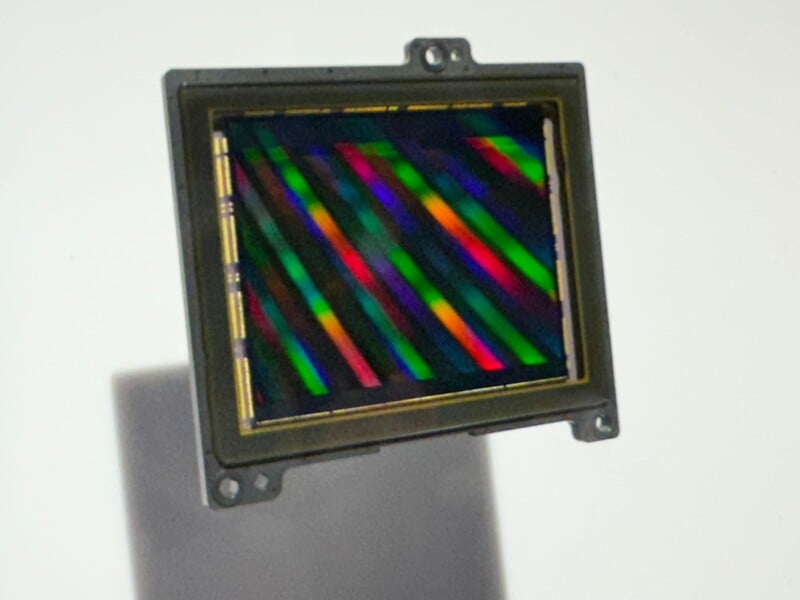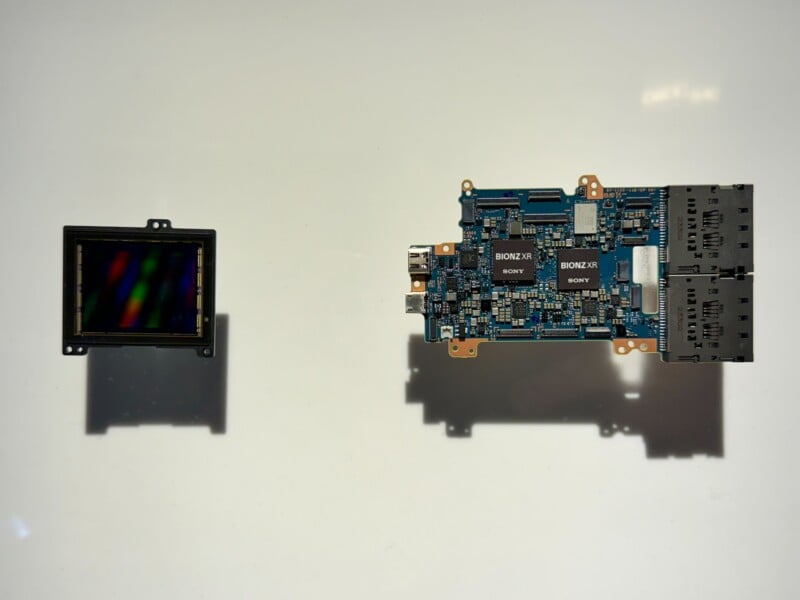![]()
It is difficult to overstate just how big of a deal the Sony a9 III is, at least on paper. As is always the case with press events, and especially ones where hands-on time is limited, pre-production firmware is installed, and shooting opportunities are cultivated, you should consume pre-release content with (many) grains of salt. Hypertension be damned.
Caveats about “pre-release marketing hype” and “beta firmware” aside, it is worth drilling down on not just the a9 III’s global shutter system itself, but also what the camera may mean for photographers come next spring when it launches and what technology like that found in the a9 III signals for the future of cameras at large.
Global Shutter System
The Sony a9 III’s global shutter system means that every single pixel of the camera’s 24.6-megapixel full-frame CMOS image sensor reads out its data at once.
To contextualize the significance of this, imagine an image sensor, comprised of row after row of carefully-organized pixels. In a typical camera, say, the 24.2-megapixel image sensor in the older a9 II, as the photographer captures an image, the light that hits the image sensor and is converted into a digital signal is progressively scanned, row by row, such that not all data is exposed simultaneously.

This has some dastardly effects in certain situations, not the least of which is dreaded “rolling shutter” distortion. When parts of the frame are exposed at different times, something moving quickly in the scene can be in different locations, even when shooting at a very fast shutter speed. In the case of sporting events, this can have a dramatic impact on something like a tennis racket, golf club, baseball bat, or even a ball.
Rolling shutter is felt acutely for video applications as well, although the focus of this article is primarily on photography.
Because a global shutter sensor does not require the use of a shutter — be it electronic or mechanical — it also means that flash sync is handled very differently. No longer must photographers worry about flash sync speeds, which are determined by a shutter’s progressive path across an image sensor. With the a9 III, or any global shutter sensor-equipped camera, photographers only need to worry about the duration of a flash itself.
While not every flash will be able to keep up with the a9 III, for those that can, the camera can sync with flash at its fastest shutter speed, which is 1/80,000s. In that extreme case, there are scant few strobes that will actually work, but the basic premise holds.
Another huge benefit of a global shutter is the elimination of flickering and banding. With flickering lights, which are very common in a wide range of situations including at sporting venues, a long-time issue is that a light flickers at different frequencies within a single frame, which can wreak havoc on a progressive-scan sensor. With the a9 III, the entire image area is exposed at once, so whatever the state of light is at a given time is what will be exposed.
So What Took So Long?
In an article last year about a Canon global shutter sensor designed for industrial applications, PetaPixel’s Jaron Schneider wrote, “Developing a high-resolution, high frame rate, full-frame global shutter sensor is extremely expensive to produce, especially those that are designed for the creative fields.”
That was not even 12 months ago. In fact, we have been hearing about global shutters for a while. For those in the industry, it feels like Sony and other sensor manufacturers have been talking about global sensors for so long. But for a majority of that time, the talk of a global shutter sensor has been merely aspirational. Sure, global sensors exist, and have for a time, but they have been utilized in limited ways and never in a camera like the a9 III.
PetaPixel asked numerous Sony representatives on hand at the company’s big a9 III reveal and it sounds like there was not some singular breakthrough moment that led to the a9 III. This is not so surprising, as there is rarely an “eureka” moment in technology.
That should not take away from the achievement here, though, because something groundbreaking like the a9 III, even if not the result of one big moment is the culmination of many small ones.

The general theme seems to be incremental and iterative technological improvements that finally could be brought together into a single flagship-level product. It is important to appreciate that the a9 III’s sensor, while impressive, means little if there are not the components to support it in the context of a functional, worthwhile interchangeable lens camera.
The sensor needs the processor, which needs chips, transistors, and memory. These hardware components not only require software, but they also must be small and thermally efficient enough to operate within a camera that offers photographers and videographers specific functions and features.
Oh, and who can forget cost? This all needs to be done in a way that is sustainable at scale and able to be sold at a price that the market will support.
Are There Limitations?
And it is not just the underlying technology that has kept a full-frame global shutter system camera from hitting the market — it is concerns about the compromises required to achieve a global shutter system that matter, too.
While Sony has proven tight-lipped about what sort of image quality sacrifices may be at play with the a9 III relative to the a9 II or even something like the Sony a1, which remains a phenomenal blend of speed and resolution, it is no secret that global sensors, in the various forms they have taken so far, often give something up in terms of imaging performance.
![]()
Thus far, global shutter sensors have delivered narrower dynamic range and different (worse) ISO performance, all else equal. While RAW image files from the a9 III cannot be processed yet, so substantive image quality analysis is at this point impossible, there are some things that are already known.
The camera’s base ISO is 250, for starters, which is a stop and a third higher than the a9 II’s base ISO. Consider the a9 II’s dynamic range performance, and the move from that camera’s native ISO of 100 to ISO 250 includes about a one-stop reduction in dynamic range. That is not nothing.
PetaPixel was able to squeeze out a tidbit of information from Sony that suggests that the a9 III’s dynamic range performance should be at least similar to the a9 II, although there is some reason for skepticism.
Of course, even if there is some testable dip in dynamic range performance, that does not necessarily suggest that any reduction in dynamic range will be evident in real-world images. Splitting hairs on test charts is not always congruous with real-life photography.
The a9 III’s native ISO also peaks at 25,600, which is half of the a9 II’s maximum native ISO. Admittedly, it’s easy to wonder how frequently the camera’s insanely fast shutter speed will actually be worth using — or if it is usable at all. However, that is, at this juncture, an unanswerable query.
Some other tidbits are that it appears not to be a dual-gain image sensor, nor is there any specific information concerning the sensor’s full-well capacity. Many of the intricacies of the a9 III’s image sensor are impossible to determine yet.
The Primary Takeaway
What is possible to determine, at least at a high level, is that the Sony a9 III — thanks in large part to its global shutter system — is maybe Sony’s most important camera ever.
Will the a9 III be the best tool for every photographic application? Absolutely not, no matter how its real-world imaging performance shakes out. But the camera will enable certain images that have never before been possible, including high-speed work with flash and extremely clean, distortion-free action photos. It will also, by virtue of its speed, capture moments that would have been missed with other cameras.
There is no such thing as the perfect camera for everyone, but the a9 III may very well prove to be the perfect camera for some. It is undetermined how large of an audience that group will be, but it is already crystal-clear that the Sony a9 III will leave a lasting impact not only on Sony’s Alpha system but on interchangeable lens cameras as a whole.
If anyone thought that Sony was perhaps resting on its laurels in recent years, or worried that the company had lost its thirst for innovation, the a9 III will disabuse them of that notion.
Image credits: Unless otherwise noted, images courtesy of Sony
